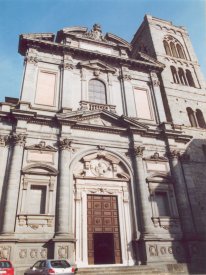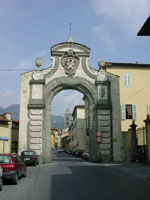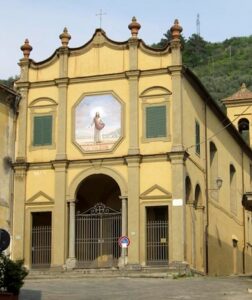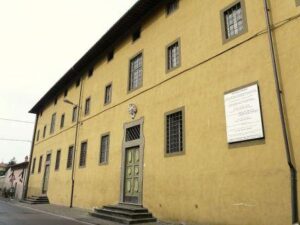The Cathedral of Santa Maria


Recommended time to visit at least two hours
Fiorentina Gate – Palace Ansaldi – Giusti Home – Monastery of the Visitation-Cathedral of Santa Maria Assunta – S. Mary Magdalene – Episcopal Palace – Episcopal Library – Church of St. Michelino – Episcopal Seminary – Palace Ricci – Via Sterponi – Palace Flori – The bridge of the Cathedral.
This should give think the clever traveler, as the town of Pescia and his people owe a lot to some rulers and members of the Tuscan court, Leo X, born Giovanni de Medici, elevated the church of Pescia of S. Mary Prelature Nullius (no Bishop of), giving the entire jurisdiction of the Valdinievole, which was so detached from the diocese of Lucca. Another figure, that tied Pescia to the Medici was Cosimo III, who in 1699 elevated the resourceful Community to the rank of Granduchy city. Beyond the gate, on the right of G. Giusti street, the ancient Florentine road, is the nineteenth-century Magnani Palace that for a century has been family owned Ansaldi. Between the members of the family is one Innocent (Pescia 1734 – there 1815), noted painter and art historian, intellectual of Risorgimento.
On the left, just left the house that, it can not remain unnoticed by the vast architectural mass of the monastery of the Visitation. The work, maid between 1722 and 1730, has a fairly compact facade, punctuated by regular windows with designed frames. In the final part of this façade is the church of San Giuliano of the Visitation. Designed by Giovan Battista Foggini (Florence, 1652 – There, 1737), is characterized by a beautiful portico with three naves. Inside, the beautiful baroque architecture divides a classroom of great dramatic effect. On the wall of the apse there is the painting of James Tais representing the martyrdom of San Giuliano. Opposite the church of the Visitation is the house of maternal grandfather of the poet Giuseppe Giusti (1809-1950). The palace, now owned noble Anzilotti Gambarini family, has, unlike other city buildings, only a single row of windows on the first floor. Just to the right, past Giusti Palace, you can take one of the most characteristic roads of Pescia, Via Mozza, so named for its short distance, ending with a small door that leads into the charming street of the walls. In this pedestrian path, remained unchanged over time, you can enjoy the sight of the ancient part of the fourteenth-fifteenth century walls and the pleasant hill. Going back on Giusti street and the road to the imposing tower of the cathedral, on the left is the arch of Pozzino. The stone arch, maibe derived from the ancient walls, today, separates Don Minzoni square from Florentine street and brings together two beautiful buildings, that was of the canonicals of the Cathedral and that of the Bellandi family. Covered the area in front of the “Canonical Provost” and passed the block of houses which are, in the past, houses of the canonicals of the collegiate church, you are in front of the Chathedral. The Cathedral of S. Maria Assunta don’t have a real square before, but the road engage a large part of the churchyard of the Cathedral. We are right in the religious heart of the city. Preceded by the beautiful fourteenth-century bell tower, is the great facade of the cathedral: the imposing twentieth-century architecture, designed by Giuseppe Castellucci of Arezzo at the end of the nineteenth century, it hides the medieval origin of the building. In fact, the first church dates from the ninth century and underwent major renovations in the thirteenth century. But the main processing building took place in mid-seventeenth century when the canonicals of the Cathedral decided to enlarge the classroom and the presbitery. A historiographical tradition informs us that the architect who followed the work was Antonio Ferri, new research has instead led to think of another character, Thomas Ramignani from Pistoia. Unfortunately it took several years to rebuild the church, it was completed in 1696 and remained for two centuries with a façade in bare brick. Remain to witness of the medieval age the blind arches that are on the outer sides of the church and the beautiful marble lectern placed on the presbitery. This is a unique group, consisting of various components of the old pulpit of the church, dating from the thirteenth century. The Duomo, inside, shows an elegant and severe architecture: three chapels on each side facing the wide nave covered by a vault. Important cornices, pilasters and capitals mark a harmonic solemn atmosphere, beautiful paintings decorate the tabernacles of colorful marble. The building of the Cathedral is full of traditions and histories, and is mirror of the city’s cultural. On the right, at the entrance, we can see, in front against the marble plaque of Rustico priest who died in 1132. At the top is the beautiful stone, also of marble inlay, which commemorates the Provost Lorenzo Mancini, Ordinary of the church from 15 December 1704 to 7 March 1707. On the other side is the monument of R. Bilancini to Giuseppe Giusti. The Chapel Raffaelli, which preserves the canvas of nineteenth-century of Luigi Norfini (Pescia, 1825 – There 1909), exposes a beautiful stone work, in a niche, on the left, is a bust of Giovanni Pacini, (Catania, 1796 – Pescia, 1867) famous composer, who spent in Pescia the last years of life. The next chapel, once the patronage of Florio family, is adorned by the beautiful painting of Pietro Donzelli of the end of the seventeenth century and depicts St. Carlo Borromeo that administers the SS. Viaticum of the plague. In the lunettes on the side are two statues of Quirino Coli and Sebastiano Piccini, representing the first on the right, S. Girolamo and the second S.Joseph with the flourished scepter.
The third chapel belonged to Forti family, which includes among its members, the bishop, Msgr. Pietro Forti, who held that office from 1847-1854. The bishop, therefore, is portrayed a half-length portrait in a lunette on the left wall of the chapel. The picture on the central altar is by Giuseppe Bottani (Cremona, 1717 – Mantova, 1784) whose iconography theme is the Virgin Birth.
After observing the pulpit of 1766 which is on the pylon right of the central arch, we enter the area of the transept to admire the beautiful chapel of SS. Sacramento, which is the chapel of Turini that according to tradition designed by Giuliano di Baccio d’Agnolo (Florence, 1462 – Florence, 1543). The best-known character of the family was Msgr. Baldassarre, who worked in Rome as officer for the Popes Leo X and Clement VII. The particular mausoleum of the great Baldassarre was executed by Raffaello di Bartolomeo Sinibaldi, said da Montelupo (Montelupo (FI), 1505 – Florence, 1566), while the marble figures to the side of the presbitery are work of Pierino da Vinci (Vinci, ca. 1530 – Pisa, 1553), nephew of Leonardo.In the floor in the middle of the chapel is the tomb of Archbishop Angelo Simonetti, Bishop of Pescia 1908 to 1950. To the prelate was reserved this important place for having ruled the diocese for 42 years with loving zeal. In the presbytery floor is the meridian wanted by the Bishop of Pescia Donato Maria Arcangeli 1742 to 1772). A century wooden choir fills the space of the apse, while the banks were built in the nineteenth century.
At the center of the apse is located in a beautiful marble frame, the big picture of Luigi Garzi from Pistoia (Pistoia 1638 to 1721 Rome), representing the Assumption of the Virgin. On the left is the large wooden episcopal chair built by Bishop Mgr. Francesco Vincenti, who was Bishop of Pescia 1773 to 1803. In the middle of the floor is the tombstone of the Prevost Ricci, who left three thousand crowns, and many legate to the construction of the new provostship of Pescia.
The room of the sacristy of the chaplains is furnished with wonderful desks of the fifteenth century. On the first two branches of the desk to the left you can see the blazons of Pope Pio II Piccolomini. The desks were commissioned from Giovanni di Michele from San Pietro a Montichiello, in 1476, by Cardinal “Papiense” Ammannati Jacopo (1412-1476) in Villa Basilica. It is furnished with desks instead of 1650, the second sacristy of the canonicals of the cathedral. The hall was built around 1646 and exhibits important paintings, on the right is the portrait of Monsignor Giovanni Ricci, a work by Bartolomeo Orsi; in the center, above the seventeenth-century desk is a beautiful painting by Pompeo Caccini representing the miraculous fishing of S. Peter. On the left is a portrait of Monsignor Baldassarre Turini, also this attributed to the painter Bartolomeo Orsi. On the front door of the sacristies is a painting representing the martyrdom of St. Lorenzo, by the end of the sixteenth century. The font of the putto holding the basin, is work of the seventeenth century.
are back in the great nave, on the right, looking at the front door of the church, there are also three chapels: the first, dedicated to St. Lorenzo, had the patronage of the Cecchi family, on the altar is the magnificent painting by Anton Domenico Gabbiani, (Florence, 1652 – Idem, 1726) while to the side are the wall tombs, whit cantilever sarcophagi and busts, of Stefano and Giovan Battista Cecchi, both proposed canonicals of Pescia in the seventeenth century. The painting that adorns the top is always work of Gabbiani.
The second chapel, dedicated to Madonna of the Rosary, as religious seat of own Company, was built at the end of the seventeenth century, while the altar was built in 1716; in the tabernacle is the large painting by Antonio Franchi (Villa Basilica (Lu), 1638 – Florence, 1709) in 1700. This shows, behind the Madonna holding out the rosary to St. Domenico, St. Dorotea, patron saint of Pescia and St. Caterina of Alessandria. In this chapel, in 1795, was placed the coffin containing the mortal remains of St. Allucio. The third chapel, once seat of the Baptistery, is now dedicated to Sant’Allucio; placed on the altar is a painting by Romano Stefanelli, created in 1985 by Monsignor Giovanni Bianchi (Bishop of Pescia 1977 to 1994). In the chapel is located the sixteenth century baptismal font, which is just above the picture attributed to Alessandro Bardelli, while in the presbitery is a beautiful sixteenth-century wooden crucifix. In the nave of the chapel, as beneath the high altar, are two stone ruins of the church of S. Maria of Pescia. It’s assumed that these two sculptures of the thirteenth and fourteenth century had been part of the façade and that were located above the entrance doors.
The bell tower, which is characterized by great aperture to the ground floor, is maiby medieval, was rebuilt in the fourteenth century and in 1776 the dome was built by the then bishop, Donato Maria Arcangeli. After passing the arch of the bell tower, entering the cloister of the Bishop’s Palace. Reconstructed at different times, the Bishop’s palace of Pescia is characterized from high balcony that, in the second half of the eighteenth century, Msgr. Arcangeli used it for astronomical observatory. Inside the building there is the Bishop’s Chapel, adorned with a beautiful glazed terracotta altarpiece attributed to Andrea and Luca della Robbia in the mid-fifteenth century. Another work worth mentioning is the altarpiece by Domenico Soldini representing the Madonna with the Child between Saint Giovanni and Saint Caterina in the middle of the sixteenth century. Opposite the cathedral is the beautiful church of S. Maria Magdalena, a temple revered by popular compassion of Pescia. On the baroque altar, decorated with sculptures of angels by Giovan Battista Ciceri, will keep the crucifix said “Magdalena”.
The wooden work from the second half of the fourteenth century and its history, as its origin, is rich in traditions and legends. Since 1700, every twenty-five years, the crucifix is carried through the streets of the city and on that occasion, called “Celebration of May”, the buildings and the hills are illuminated with wax candles. In the sacristy of the company of SS. Crucified on a wooden bench, is a fifteenth-century wooden copy of the Holy Face of Lucca.
Along the cathedral and along the namesake street, you can see, as well as the unique path that leads uphill to a place called “Grufaia”, the beautiful palace of the sixteenth Cardini, Matteucci today. On the right, adjacent to the church, is the residence of the Cathedral Chapter, and seat of the secret archive and of the Library. The latter, known for beautiful code that maintains, is adorned with beautiful paintings dated 1711 of the artist’s Pietro Scorsini of Lucca. The library contains about 10,000 volumes. In the bibliographic units of the library, which was founded in 1648 by the will of Monsignor Romualdo Cecchi, are retained 42 incunabulum, 100 manuscripts of the XV-XVIII centuries and a fine collection of prints of the sixteenth-seventeenth century, from Rome.
Going again along the way to the Cathedral and the Palace Matteucci, we reach the small church of S. Michelino. The Romanesque facade with stone quoins lead us to suppose that the building is of very ancient origin. The roof of the church still retains the cover of pavers. Leaving the church, should be continued for the small road bordered by the wall of the precious garden of the “Marquis” and the side wall of the church of S. Chiara, so we arrive in Piazza Garzoni where, in the second half of the fifteenth century, was built the convent of Poor Clare Nuns on land that was given to them by individuals. Unique is the beautiful cloister of St. Chiara that it was restored in 1582. The building, of the second half of the eighteenth century, passed to the diocese of Pescia in the same year became the seat of the Episcopal Seminary.
Leaving Piazza Garzoni and started by Fontana street, you can admire buildings and portals of remarkable stylistic level. Fontana street, once Florentine street, is one of the most original streets of this part of the town.
At the end of the road, when you get into Sterponi street on your right, you can see the splendid facade of Ricci palace, one of the most interesting seventeenth-century architecture that are in town. On the facade you can see the two blazon of marble that were of the “magnifico” provost Giovanni Ricci. He lived in the first half of the seventeenth century and, from 1634 to 1646, rebuild the family home. The restoration of the palace was given to Pantaleone Quadri, architect and engineer from Pistoia who designed the facade around 1640, and carved the stipes of the five new windows and it affixed the stone cornices. In the restoration the provost decided to build the beautiful loggia with the twin columns overlooking the garden. In the final green area, down the little path, with a circular fountain placed in the middle, is the eighteenth-century brick and stone fountain, built by Forti family that in the second half of the seventeenth century became the owner of the building. In the facade, protected by iron railing, there is the beautiful fountain which is opposite Sterponi street. Composed of a marble basin supported by a pillar, which local tradition says of Roman age, is characterized by the sculpture of the Dolphin – symbol of the city which is said by Innocenzo Ansaldi (Pescia, 1735 – idem, 1816).
Via Sterponi is distinct from the large size of a building that is on the right and that was once an important monastery of the Carmine nuns. Returning to the Cathedral from Cavour street, crossed the square of Ducci, appear to us the beautiful facade of the church, the imposing bell tower and the buildings that were adapted around 1850 just because of the opening of this road, completed in 1864. Near the church of S. Mary Magdalene is Marchi street that leads to the square Anzilotti, in whose area you can see an walled arc in the outer wall of a house. These stones are the remains of the Gate of Bonajuto that was inserted into the city walls and which was demolished around 1914.
To the left is the small street off of the “Porta Vecchia” characterized by Sainati Palace, once home of the Flori family who wanted the rooms of his house decorated and frescoed by Gian Domenico Ferretti (Florence, 1692 – ivi, 1768). The façade exhibits a series of window with frames, hupstairs on the right, there is precious marble blazon of Flori house, that in the eighteenth century was home of Prince Gian Gastone de Medici.
Before leaving the district, right in the area called “sdrucciolo del duomo” (Ducci square), you can see the Palace of the Cecchi family with a beautiful internal portico, with its columns and capitals of the Renaissance age. This palace was home for a few days in 1541 of Pope Paolo III, during a visit to the noble families of Cecchi and Ducci. Destroyed during the war, the Bridge of the cathedral was rebuilt in 1946 keeping in mind the original architecture dating from the eighteenth century. The sign of a city between devotion and civic sense duty, each year in early May, Pescia live a particularly vivid moment of celebration. The celebrations are linked to the SS. Crucifix which is adored from immemorial time in the Sanctuary of St. Mary Magdalene. On the evening of May 2 the city and the hills are illuminated with wax candles, and the next day, at the end of the procession is the great liturgical celebration with the offer of oil by one of the four districts of the city. Every twenty-five years, the celebrations are more solemn and the crucifix is shifted in the Cathedral and on the evening of May 3 is carried in procession.

